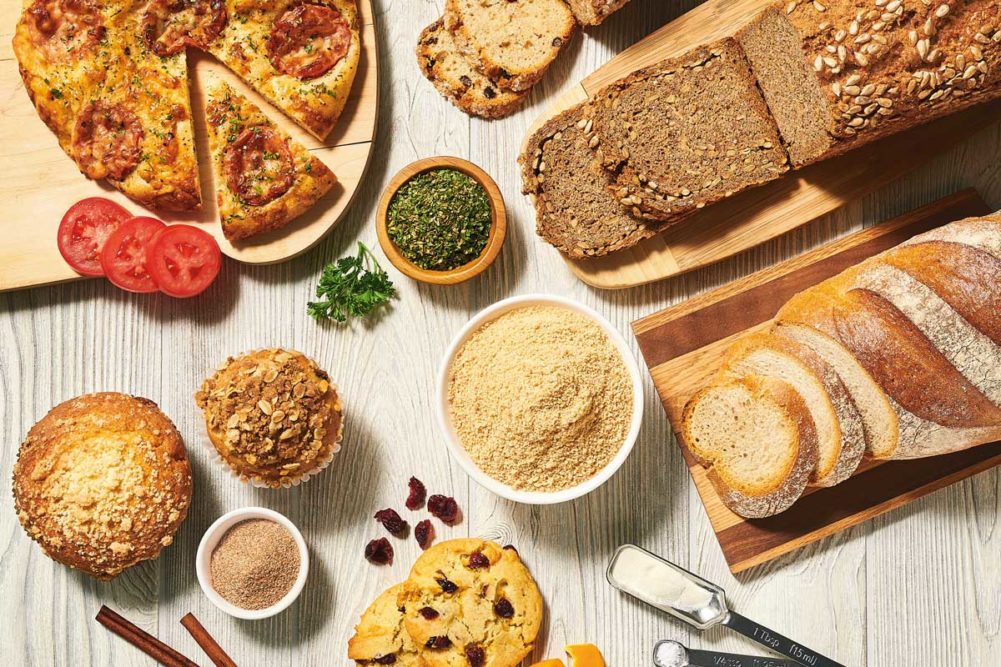Sugar reduction in baked goods, especially those with other better-for-you ingredients and claims, can be a tricky puzzle to solve. But with a robust stable of sweeteners, flavor modifiers and other ingredients, formulators can put the pieces together to create a great-tasting, reduced-sugar product.
Bars, muffins and even cookies with value-added nutrition fulfill the demand for permissible indulgence, products that consumers feel less guilty about enjoying because of their added health benefits or clean labels. Snacks with double-digit protein claims, for example, are popular, but the proteins used in grain-based bakery bases can taste very bitter.
“Adding a bitter masker to the blend allows for a more uniform flavor,” said Hanna Santoro, senior scientist, baking development and applications, ADM. “Ancient grains, such as quinoa, millet or pulses, can also contribute a bitter taste experience. Our masking solution is customized to create a grain note that has a finish closer to traditional wheat flours.”
In combination with starch and gum systems, this technology mimics the functionality of wheat flour. This allows a baker to replace most, if not all, wheat flour in a recipe with alternative grains or pulses and still deliver a comparable-tasting finished product.
“Masking is often required when we reduce sugar in baked goods because the grain notes and other components in the product become unbalanced in flavor,” said Shari Mahon, chief of global flavor application technology, Sweegen. “When reducing sugar in a whole wheat bran muffin, for example, natural flavors help mitigate the bitterness, reduce the astringency and cut the linger to bring the balance of the product back to a full-sugar profile. We may also add sweet enhancers to mimic a brown sugar-type note."
[Related reading: The many roads to sugar reduction]
“When reducing sugar in oat products, such as a raisin oatmeal breakfast cookie, and replacing it with high-intensity natural sweeteners and bulking fibers, the bitterness and linger are amplified without the sugar to balance out the taste,” she continued. “We use our building block flavor technologies to rebalance the flavor. This is in addition to a brown bakery enhancer to mimic the baked sugar notes to deliver a full-sugar cookie taste experience to consumers.”
Unexpected off-flavors may occur in baked goods over shelf life as a result of ingredient interactions or environment. Overuse of some ingredients may result in the development of these unwanted flavors.
“When using natural colors derived from vegetables, unwanted flavor notes such as a bitter taste of cabbage or radish may develop,” said Richard Mundy, research and development manager, Dawn Foods. “A bitter masker would be recommended here.”
Adding omega-3 fatty acids — either directly as an isolated ingredient or via a whole food ingredient such as flaxseed — continues to trend in the baked goods sector. These fatty acids, especially over time, in certain instances may contribute fishy-tasting off-notes to the product. Sugar can often hide these tastes, but in reduced-sugar products, more sophisticated ingredients are necessary.

Natural plant extracts, such as rosemary extract, function as antioxidants and slow the development of rancid off-flavors. In many delicately flavored or neutral-tasting baked goods, such as a loaf of bread, modifying flavors may be necessary.
“The keto diet trend is causing a rise in demand for items with no added sugar,” Ms. Santoro said. “We use a sweetness modifier and masker in combination with high-intensity sweeteners to give the consumer a perceived sweetness that is reminiscent of cane sugar. High-intensity sweeteners alone do not have the same eating experience as traditional sugar and usually have peaks in which sweetness is perceived. Combining a sweetness modifier and flavor masker removes off-notes and allows sweetness to come through from beginning to end.”
Roni Eckert, senior food scientist, Wixon, recalled the challenge of making a keto crust with cauliflower, pea protein and egg whites, and the process of getting the flavor just right.
“Together these ingredients had some undesirable flavor notes,” she explained. “Using a proprietary flavor technology that masks astringency notes, we were able to help eliminate the drying note the protein — both egg and pea — was leaving in the mouth while eating.”
Sugar doesn’t just contribute to flavor but also mouthfeel as it provides bulk to a bakery formulation. This is a similar issue in low-fat products and the missing rich texture from the missing fat. Formulators looking to replace that texture can find some solutions in reduced fat products.
“Mouthfeel enhancers used to help create the perception of body in fat-based products are also used in sugar-reduced items in order to help build back mouthfeel when sugar is removed,” Ms. Eckert explained.
[Related reading: Mimicking chocolate and vanilla flavors in baked foods]
Chocolate baked goods come with a unique set of issues, as cocoa is a bitter ingredient and requires sweetener. The darker the chocolate, often the greater the issue. Dark chocolate, with its high antioxidant content and healthful halo, is often sought out for that permissible indulgence quality.
A cocoa enhancer will boost the perception of cocoa, Ms. Eckert added. When used in combination with a sweetener enhancer, cocoa costs may be reduced along with sugar content.
“Astringency and bitter blockers help to mask the drying and sometimes bitter notes in gluten-free baked goods,” she said. “This occurs when a protein supplement, in the form of a grain-free material, is used in place of the protein in wheat flour. It often leaves a dry, gritty flavor.”
For example, a natural snack bar with added pea protein would include a masking flavor to optimize the base of the bar so it doesn’t have the negative sensory attributes contributed by the pea protein, said Tony Moore, chief innovation officer and chief flavorist, Flavor Producers.
“A natural creamy vanilla flavor may be selected to optimize the base and mask the protein before the characterizing profile flavor is selected,” he explained.
This article is an excerpt from the November 2020 issue of Baking & Snack. To read the entire feature on sugar reduction, click here.





